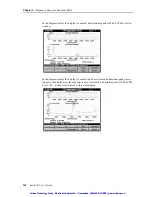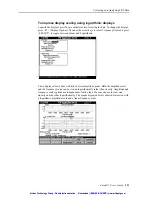
216
dataPAC User’s Guide
Chapter 6 - Frequency Response Function (FRF)
Accelerometer
You use an accelerometer to collect the response data with the FRF Module. You can use
any accelerometer compatible with the dataPAC instrument.
The force hammer you use, the type of hammer tip, and the expected frequency range all
contribute to the choice of the pickup used (mV/g). A hard hammer tip can create a
significant g force. Since the accelerometer range is inversely proportional to the
accelerometer sensitivity, you may want to choose a low sensitivity accelerometer to allow
for adequate response range due to the impact. The table below shows how accelerometer
sensitivity and maximum range are inversely related. The sensitivity is expressed in
millivolts per g of acceleration (mV/g).
Large massive structures sometimes require large modally tuned hammers capable of
generating a significant force because of heavy damping. When these conditions exist, you
might need a higher sensitivity transducer to pickup the small amount of energy passed on
to the response transducer. On larger structures, the added weight of a higher sensitivity
transducer and magnet mounting does not affect the response. See “Connecting the
Accelerometer” on page 220 for more details.
A good general purpose frequency response tool kit should include a variety of
accelerometers ranging from 10 to 500 mV/g. Three or four pickups within this sensitivity
range (10, 50, 100, and 500 mV/g) allows you to test a wide variety of structures.
When testing an unknown structure, it is generally advisable to start with a low sensitivity
transducer such as 10 mV/g and increase the transducer sensitivity as needed.
Note: The mass of the accelerometer should be small relative to the device under test.
Understanding the Concepts Behind the FRF Module
If you are not familiar with frequency response testing this section offers a practical
understanding of the underlying theory and goals of this type of non-destructive evaluation.
It is also important for users already familiar with frequency response testing to understand
some of the specific techniques used by the dataPAC 1500 FRF Module.
What is Stiffness?
The stiffness of a structure can be measured by the amount of force needed to move (or
deflect) the structure a prescribed distance. The force is normally measured in pound-force
(lbf) or Newtons (N). The displacement is measured in inches (in) or meters (m). Stiffness is
expressed as a ratio of the force it takes to displace a structure a given distance.
Sensitivity
mV/g
Amplitude Peak
g peak
10
500
50
100
100
50
500
10
Artisan Technology Group - Quality Instrumentation ... Guaranteed | (888) 88-SOURCE | www.artisantg.com
Artisan Technology Group - Quality Instrumentation ... Guaranteed | (888) 88-SOURCE | www.artisantg.com













































